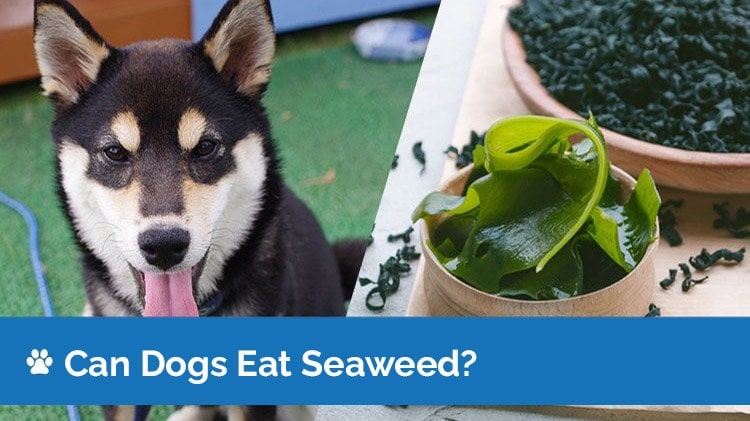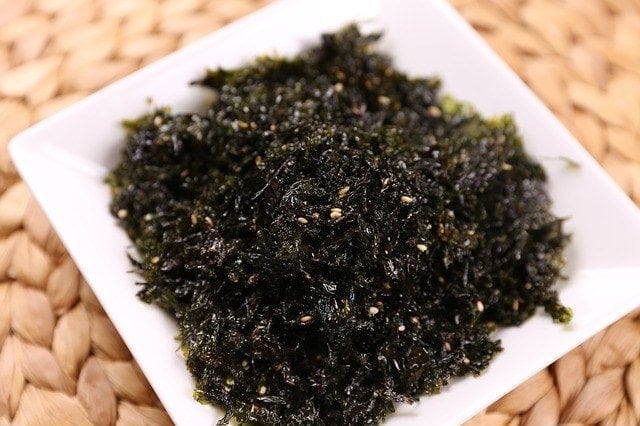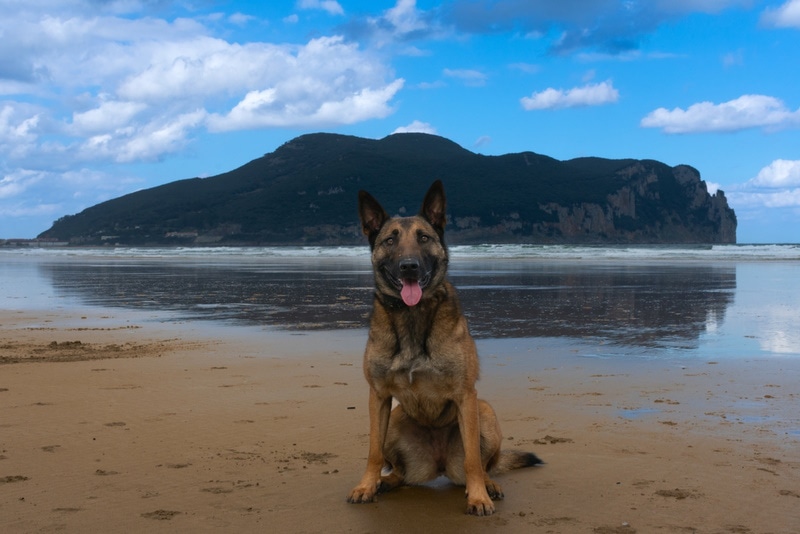Can Dogs Eat Seaweed? Vet Approved Nutrition Facts & FAQ

Updated on

Seaweed: a uniquely flavored snack. Some people love it, some people hate it, but most have an opinion about it either way. Is seaweed safe for dogs? Have you ever wondered what your dog may think about the taste, or if they should even eat seaweed?
The answer is a cautious yes, as dogs can only eat small amounts of some types of edible seaweed. They can even get some great nutrients from it — if provided in moderation.
And what do we mean by “edible seaweed?” Essentially, almost any seaweed that humans can eat can also be eaten by their canine companions, of course in much smaller amounts. This includes packaged seaweed sheets and nori.
Letting your pup chow down on seaweed washed up on the beach, on the other hand, is inadvisable and often very harmful to them. A simple rule to follow here is, can you identify it as an edible seaweed? If not, then dissuade your dog from making a meal of it.
Health Benefits of Seaweed for Dogs
As a treat, clean and prepared seaweed can be incredibly healthy and beneficial to most dogs. However, you will first need to confirm this with your vet, as this may not be suitable for your pooch.
Seaweed is nutrient-dense and packed with good things like fatty acids. Omega-3s in particular can support canine brain development, joint health, and healthy skin and coats. There is ongoing research under way to confirm or deny many of the other potential claimed benefits of omega-3 in dogs.1

Wakame seaweed, for example, is full of the omega-3 fatty acid and eicosapentaenoic acid and is one of the richest plant sources for that nutrient in the world. However, that is not to say that seaweed is necessarily something you should feed your pup every day. Moderation and caution are key when making changes to your dog’s diet. An excess of omega-3 fatty acids can also be harmful, particularly in some dogs.
Some seaweed may help overweight people burn off excess fatty tissues with the help of a compound known as fucoxanthin. Potential health benefits of this compound in dogs are still being studied, including some potential benefits for canine heart health and some types of cancer. Do take the results of these studies with a pinch of salt, as the study populations are very small and the results are based on just a few dogs. Further research is crucial to characterize this better.
Can Seaweed Be Bad for Dogs?
Just like any food, too much of a good thing can be harmful.
In fact, a few types of edible seaweed that humans enjoy can have small amounts of inorganic, toxic metals in them. Nori seaweed is a prime example.
The heavy metal content is extremely variable based on the location the nori was harvested from and its quality. But to be safe, daily consumption of large amounts is not advisable — for people or dogs! Speak to your vet about the appropriate amount for your dog.
There isn’t a lot of available research about the potential of seaweed causing allergic reactions even in people, and it is considered rare. So we cannot draw any conclusions at this point if this would be a genuine concern in dogs.
Furthermore, even the completely safe types of seaweed are not an “eat this and be healthy” sort of cure-all. Just like human nutrition, canine nutrition needs some nutrients to be carefully balanced to get all the benefits out of them, and this guidance is provided by the American Association of Feed Control Officials.
Dogs are omnivores but do best with the majority of their calories and proteins coming from healthy meats. While canines can get nutrients from and digest grains as well, plants can be more challenging depending on the amount of cellulose. Dogs cannot digest cellulose without the help of bacteria in their gut.
High amounts of omega-3 in seaweed can also have some downsides, especially if your dog is getting it in their balanced diet and seaweed supplement or snacks on the side, leading to a very high dose. Always speak to your vet when considering omega-3 supplementation, as it’s not indicated in all dogs and there may be side effects. If your dog is prone to stomach upsets and pancreatitis, is taking anticoagulant medication, or has been diagnosed with diabetes, special precautions should be taken and veterinary advice sought, as these supplements may not be appropriate for them.

Besides being a little harder to digest, another special concern is that seaweed can also be incredibly chewy, and sometimes hard to swallow. Some seaweed is prone to clumping, which may result in hacking and coughing.
Some dogs are notorious for scarfing down food and not chewing very thoroughly. The texture of seaweed means that gulping it down could seriously increase the risk of choking or intestinal blockages.
If your dog eats at lighting speed, try giving them dried and ground seaweed in small amounts, or just avoid them altogether.
In other words, carefully consider the portion size of any seaweed you feed your dog and whether it is actually appropriate for your pooch. Talk to your vet if you want to make seaweed part of your dog’s regular diet.
What to Do if Your Dog Eats Seaweed
Some kinds of seaweed can be healthy in small amounts for your dog. But what if your pooch eats an entire bag of nori, or goes to town on a lump of unidentifiable kelp on the beach?
Call a veterinarian immediately in cases such as either of those. Dogs are often curious about seaweed found washed up on the beach and may try to eat it. The stalk is the hardest part and may block the dog’s stomach and intestines. Seaweed also has a tendency to absorb water when in the stomach, which makes it swell up. This is how it can damage the stomach and intestinal lining and lead to a life-threatening blockage that needs urgent veterinary attention.
Eating beach seaweed may also cause your dog to ingest excessive quantities of saltwater, which can irritate their stomachs and cause an imbalance of electrolytes and dehydration. Additionally, seaweed can absorb all kinds of pollution and toxins, so you’ll want to get your dog checked out by a vet as soon as possible.
And when it comes to identified, edible seaweed, even the safest ones can cause gastrointestinal distress when eaten in large amounts or by particular dogs.

How to Feed Seaweed to Your Dog
As we just mentioned, seaweed can be challenging for some dogs to chew and swallow.
To be on the safe side, if you want to consider seaweed for your dog, consult with your vet first about the appropriate amounts and preparations, and look for vet-approved and dog-safe products. We recommend giving seaweed to your pup in a dried form or chopped very small in with other food, plain and unseasoned, in moderate amounts based on your vet’s recommendation. Seaweed is rich in iodine, so an excess of these products can be harmful to the dog’s thyroid gland.
Always check the ingredient lists of any seaweed you buy and avoid those that are put through processing that loads them with unhealthy things like salts and refined sugars. Also make sure they don’t contain any seasonings like garlic that are harmful to dogs.
Keep fresh water in their bowl nearby too, which will keep your pooch well hydrated and help food move through their digestive system smoothly.

Types of Seaweed to Feed Your Dogs
Wakame
Wakame is a marine algae and sea vegetable with a slightly sweet, distinctive flavor and texture. It is most often found dried and should be rehydrated before eating. Wakame is rich in sodium, so make sure to consult with your vet before offering it to your dog.
Nori
Nori is a red algae that is used in Japanese cuisine, and often seen as a wrap for sushi rolls or rice balls. You can most commonly find it as dried sheets.
Please note that this seaweed can sometimes contain trace amounts of arsenic and cadmium, and letting your dog ingest large amounts is highly discouraged. Never give your dog nori as a part of sushi, as raw fish is not safe for them.
Kelp
Kelp is a large, brown algae with over 30 varieties that is used in Chinese, Korean, and Japanese cooking. Kelp is used to flavor broths, as a garnish or vegetable, and in snacks. It can be served dried, raw, or cooked.
Kombu
One of the most widely used edible kelps, kombu is usually bought dried or pickled in vinegar. Avoid the vinegar for your pup, but feel free to let them try plain broth made with a little bit of kombu, but without any seasonings, garlic, additives, or salt.
Sea Grapes
This soft, succulent seaweed is a species of green algae native to the Indo-Pacific region. And it really does look rather like a bunch of very small grapes! It is beloved by people of the Philippines, Malaysia, Japan, and Vietnam. Sea grapes are most commonly eaten raw. There is no safety information on this type of seaweed in dogs, so it’s crucial to consult with your vet before offering any to your dog, and be mindful that small dogs may try to swallow them whole and quickly, which can lead to choking.
Final Thoughts on Feeding Seaweed to Your Dog
So, should you feed your dog seaweed?
Random beach algae? Definitely not!
On the other hand, cleaned, edible seaweed or vet-approved seaweed snacks may be a delicious occasional treat. Many types of seaweed can confer health benefits to dogs, but you should always err on the side of caution and keep portion sizes small.
Talk to your vet before making any drastic diet changes and ask them what amounts and kinds of seaweed your dog can try!
Featured image credit: Shutterstock












